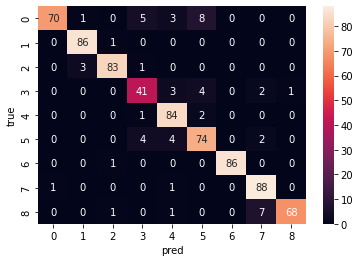はじめに
- 今回はKerasでLSTMを用いた多クラス分類を実装してみます。livedoorニュースコーパスの多クラス分類を行ってみました。
データの取得
- データセットはlivedoor ニュースコーパスを使用しました。こちらの記事を参考にDataFrame化を行いました。
# Livedoorニュースのファイルをダウンロード&解凍
! wget "https://www.rondhuit.com/download/ldcc-20140209.tar.gz"
!tar -zxvf ldcc-20140209.tar.gz
# tsvファイルの作成
!echo -e "filename\tarticle"$(for category in $(basename -a `find ./text -type d` | grep -v text | sort); do echo -n "\t"; echo -n $category; done) > ./text/livedoor.tsv
!for filename in `basename -a ./text/dokujo-tsushin/dokujo-tsushin-*`; do echo -n "$filename"; echo -ne "\t"; echo -n `sed -e '1,3d' ./text/dokujo-tsushin/$filename`; echo -e "\t1\t0\t0\t0\t0\t0\t0\t0\t0"; done >> ./text/livedoor.tsv
!for filename in `basename -a ./text/it-life-hack/it-life-hack-*`; do echo -n "$filename"; echo -ne "\t"; echo -n `sed -e '1,3d' ./text/it-life-hack/$filename`; echo -e "\t0\t1\t0\t0\t0\t0\t0\t0\t0"; done >> ./text/livedoor.tsv
!for filename in `basename -a ./text/kaden-channel/kaden-channel-*`; do echo -n "$filename"; echo -ne "\t"; echo -n `sed -e '1,3d' ./text/kaden-channel/$filename`; echo -e "\t0\t0\t1\t0\t0\t0\t0\t0\t0"; done >> ./text/livedoor.tsv
!for filename in `basename -a ./text/livedoor-homme/livedoor-homme-*`; do echo -n "$filename"; echo -ne "\t"; echo -n `sed -e '1,3d' ./text/livedoor-homme/$filename`; echo -e "\t0\t0\t0\t1\t0\t0\t0\t0\t0"; done >> ./text/livedoor.tsv
!for filename in `basename -a ./text/movie-enter/movie-enter-*`; do echo -n "$filename"; echo -ne "\t"; echo -n `sed -e '1,3d' ./text/movie-enter/$filename`; echo -e "\t0\t0\t0\t0\t1\t0\t0\t0\t0"; done >> ./text/livedoor.tsv
!for filename in `basename -a ./text/peachy/peachy-*`; do echo -n "$filename"; echo -ne "\t"; echo -n `sed -e '1,3d' ./text/peachy/$filename`; echo -e "\t0\t0\t0\t0\t0\t1\t0\t0\t0"; done >> ./text/livedoor.tsv
!for filename in `basename -a ./text/smax/smax-*`; do echo -n "$filename"; echo -ne "\t"; echo -n `sed -e '1,3d' ./text/smax/$filename`; echo -e "\t0\t0\t0\t0\t0\t0\t1\t0\t0"; done >> ./text/livedoor.tsv
!for filename in `basename -a ./text/sports-watch/sports-watch-*`; do echo -n "$filename"; echo -ne "\t"; echo -n `sed -e '1,3d' ./text/sports-watch/$filename`; echo -e "\t0\t0\t0\t0\t0\t0\t0\t1\t0"; done >> ./text/livedoor.tsv
!for filename in `basename -a ./text/topic-news/topic-news-*`; do echo -n "$filename"; echo -ne "\t"; echo -n `sed -e '1,3d' ./text/topic-news/$filename`; echo -e "\t0\t0\t0\t0\t0\t0\t0\t0\t1"; done >> ./text/livedoor.tsv
- 作成したtsvファイルをpandasで読み込みます。下記画像のように、クリーニングした記事の内容とニュースカテゴリのone-hot表現を持ったDataFrameが作成できます。
import pandas as pd
df = pd.read_csv('text/livedoor.tsv', sep='\t')
- 正解ラベルのone-hotベクトルの作成
# 正解ラベルのone-hotベクトルの作成
df2 = df.copy()
df2 = df2[['dokujo-tsushin', 'it-life-hack',
'kaden-channel', 'livedoor-homme', 'movie-enter', 'peachy', 'smax',
'sports-watch', 'topic-news']]
df['one-hot'] = ''
for index, rows in df2.iterrows():
df['one-hot'].iloc[index] = list(rows)
クリーニング
- 形態素解析器としてMeCabを用います。以下記事を参考にクリーニングクラスを定義しています。
Mecab+neologd辞書を用いる前に推奨される正規化
import re, unicodedata
class CleaningData:
def __init__(self, df, target_column):
self.df = df
self.target_column = target_column
def cleaning(self):
self.df[self.target_column] = self.df[self.target_column].map(self.remove_extra_spaces)
self.df[self.target_column] = self.df[self.target_column].map(self.normalize_neologd)
# クリーニングの過程でtextが空になった行を削除
self.df = self.df[self.df[self.target_column] != '']
self.df = self.df[self.df[self.target_column] != '']
self.df = self.df.reset_index()
return self.df
def unicode_normalize(self, cls, s):
pt = re.compile('([{}]+)'.format(cls))
def norm(c):
return unicodedata.normalize('NFKC', c) if pt.match(c) else c
s = ''.join(norm(x) for x in re.split(pt, s))
s = re.sub('-', '-', s)
return s
def remove_extra_spaces(self, s):
s = re.sub('[ ]+', ' ', s)
blocks = ''.join(('\u4E00-\u9FFF', # CJK UNIFIED IDEOGRAPHS
'\u3040-\u309F', # HIRAGANA
'\u30A0-\u30FF', # KATAKANA
'\u3000-\u303F', # CJK SYMBOLS AND PUNCTUATION
'\uFF00-\uFFEF' # HALFWIDTH AND FULLWIDTH FORMS
))
basic_latin = '\u0000-\u007F'
def remove_space_between(cls1, cls2, s):
p = re.compile('([{}]) ([{}])'.format(cls1, cls2))
while p.search(s):
s = p.sub(r'\1\2', s)
return s
s = remove_space_between(blocks, blocks, s)
s = remove_space_between(blocks, basic_latin, s)
s = remove_space_between(basic_latin, blocks, s)
return s
def normalize_neologd(self, s):
s = s.strip()
s = self.unicode_normalize('0-9A-Za-z。-゚', s)
def maketrans(f, t):
return {ord(x): ord(y) for x, y in zip(f, t)}
s = re.sub('[˗֊‐‑‒–⁃⁻₋−]+', '-', s) # normalize hyphens
s = re.sub('[﹣-ー—―─━ー]+', 'ー', s) # normalize choonpus
s = re.sub('[~∼∾〜〰~]', '', s) # remove tildes
s = s.translate(
maketrans('!"#$%&\'()*+,-./:;<=>?@[¥]^_`{|}~。、・「」',
'!”#$%&’()*+,-./:;<=>?@[¥]^_`{|}〜。、・「」'))
s = self.remove_extra_spaces(s)
s = self.unicode_normalize('!”#$%&’()*+,-./:;<>?@[¥]^_`{|}〜', s) # keep =,・,「,」
s = re.sub('[’]', '\'', s)
s = re.sub('[”]', '"', s)
return s
def remove_symbols(self, text):
text = re.sub(r'[◎, 〇, △, ▲, ×, ◇, □]', '', text)
return text
- クリーニングの実行
cd = CleaningData(df, 'article')
df = cd.cleaning()
形態素解析
- 形態素分析ライブラリーMeCab と 辞書(mecab-ipadic-NEologd)のインストール
!apt-get -q -y install sudo file mecab libmecab-dev mecab-ipadic-utf8 git curl python-mecab
!git clone --depth 1 https://github.com/neologd/mecab-ipadic-neologd.git
!echo yes | mecab-ipadic-neologd/bin/install-mecab-ipadic-neologd -n
!pip install mecab-python3
!ln -s /etc/mecabrc /usr/local/etc/mecabrc
- 形態素解析クラスの定義
import MeCab
class Wakati:
""" 形態素解析クラス """
# クラス変数
MECAB_PATH = "-d /usr/lib/x86_64-linux-gnu/mecab/dic/mecab-ipadic-neologd"
def __init__(self, df, target_column):
self.df = df
self.target_column = target_column
def wakati_document(self):
self.df[self.target_column] = self.df[self.target_column].map(self.wakati_sentence)
return self.df
def wakati_sentence(self, text):
tagger = MeCab.Tagger(Wakati.MECAB_PATH)
words = []
for c in tagger.parse(text).splitlines()[:-1]:
#surfaceに単語、featureに解析結果が入る
try:
surface, feature = c.split('\t')
except:
continue
pos = feature.split(',')[0]
words.append(surface)
return ' '.join(words)
- 形態素解析の実行
w = Wakati(df, 'article')
df = w.wakati_document()
テキストのベクトル化
- 日本語のままでは学習できないので、KerasのTokenizerクラスを用いて単語をベクトル化します。
- 入力する文書の長さを揃える為、各文書の単語数がmax_lenに及ばないものはpad_sequencesにて0埋めしています。
from tensorflow.keras.preprocessing.text import Tokenizer
from tensorflow import keras
class TensorFlowTokenizer:
""" 単語にIDを振り、文章をベクトル化するクラス """
def __init__(self, df, maxlen):
self.df = df
self.maxlen = maxlen
def tokenizer(self):
self.X_train, self.word_to_index, self.index_to_word = self.tokenize_column(list(self.df['article']))
return self.X_train, self.word_to_index, self.index_to_word
def tokenize_column(self, text_list):
''' 単語を数値に変換し、データ長を合わせるメソッド '''
keras_tokenizer = Tokenizer()
keras_tokenizer.fit_on_texts(text_list)
print('学習した単語数:{}'.format(len(keras_tokenizer.word_index)))
word_to_index = keras_tokenizer.word_index
index_to_word = {}
for word, index in word_to_index.items():
index_to_word[index] = word
# 文章を数値に変換
text_vector = keras_tokenizer.texts_to_sequences(text_list)
X_train = keras.preprocessing.sequence.pad_sequences(text_vector, maxlen=self.maxlen)
return X_train, word_to_index, index_to_word
- 分かち書きした文書のベクトル化
- 今回は各文書の長さを500に固定しました。
tft = TensorFlowTokenizer(df, 500)
X, word_to_index, index_to_word = tft.tokenizer()
データセットの分割
- scikit-learnのtrain_test_splitを用いて訓練データ、テストデータ、検証データに分割します。
import numpy as np
from sklearn.model_selection import train_test_split
y = np.array(list(df['one-hot']))
X_train, X_test, y_train, y_test = train_test_split(X, y, test_size=0.2, random_state=100, stratify=y)
X_test, X_valid, y_test, y_valid = train_test_split(X_test, y_test, test_size=0.5, random_state=100, stratify=y_test)
モデルの定義
from keras.models import Sequential
from keras.layers import LSTM, Dense, Embedding, Dropout
vocabulary_size = len(word_to_index) + 1
model = Sequential()
model.add(Embedding(input_dim=vocabulary_size, output_dim=256, input_length=500))
model.add(LSTM(128, return_sequences=False))
model.add(Dropout(0.5))
model.add(Dense(9, activation='softmax'))
model.compile(loss='categorical_crossentropy', optimizer='adam', metrics=['accuracy'])
model.summary()
Model: "sequential_24"
_________________________________________________________________
Layer (type) Output Shape Param #
=================================================================
embedding_24 (Embedding) (None, 500, 256) 25054464
lstm_24 (LSTM) (None, 128) 197120
dropout_11 (Dropout) (None, 128) 0
dense_20 (Dense) (None, 9) 1161
=================================================================
Total params: 25,252,745
Trainable params: 25,252,745
Non-trainable params: 0
学習
from tensorflow.keras.callbacks import EarlyStopping
callbacks = [EarlyStopping(monitor='val_loss',
patience=5, # ここで指定したエポック数の間改善がないと停止
verbose=1,
mode='max')
]
history = model.fit(X_train, y_train, epochs=30, batch_size=32, validation_data=(X_valid, y_valid), callbacks=callbacks)
評価
- 各ラベルに対する評価値は以下の通り。accuracyは92%でした。
from sklearn.metrics import classification_report
y_pred = model.predict(X_test)
print(classification_report(np.argmax(y_test, axis=1), np.argmax(y_pred, axis=1)))
precision recall f1-score support
0 0.99 0.80 0.89 87
1 0.96 0.99 0.97 87
2 0.97 0.95 0.96 87
3 0.79 0.80 0.80 51
4 0.88 0.97 0.92 87
5 0.84 0.88 0.86 84
6 1.00 0.99 0.99 87
7 0.89 0.98 0.93 90
8 0.99 0.88 0.93 77
accuracy 0.92 737
macro avg 0.92 0.92 0.92 737
weighted avg 0.93 0.92 0.92 737
- 混同行列はこんな感じでした、少しラベル3のデータが少なかったかも。学習データの偏りをなくせばもう少しよくなりそうですね。
from sklearn.metrics import confusion_matrix
import matplotlib.pyplot as plt
import seaborn as sns
sns.heatmap(confusion_matrix(np.argmax(y_test, axis=1), np.argmax(y_pred, axis=1)), annot=True)
plt.xlabel("pred")
plt.ylabel('true')
参考記事
- Sequentialモデルのガイド - Keras Documentation https://keras.io/ja/getting-started/sequential-model-guide/
- 他クラス分類の評価時にはclassification reportとconfusion matrixがめっちゃ便利なので使っていけ - Qiita https://qiita.com/takuto512/items/236b6d41c9a51ba2e2e1

